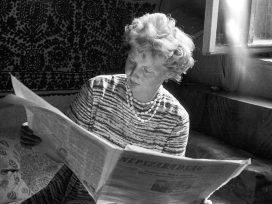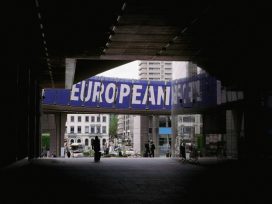The Hungarian architect László Hudec (1893-1958) is a name to be reckoned with in China where he settled for a long period, but he is almost unheard of in his home country beyond a tight circle of architectural historians and his extended family. Quite a bit has been written about Hudec outside Hungary: Luca Poncellini, an architecture student from Turin, recently completed a study which is soon to appear as Volume 13 of Holnap Kiadó’s architecture series. It’s odd that he has vanished from collective memory, as tér és forma (‘space and form’), the mouthpiece of modern architecture in the interwar years, featured one of his buildings, and Hudec kept in touch with a number of important Hungarian architects. I first came across his name decades ago when, searching the database of the Research Institute for Art History of the Hungarian Academy of Sciences, I stumbled across a newspaper article from the 1930s: a “Hungarian architect designed the first skyscraper in Shanghai, the first in Asia.”
Until recently, the Chinese paid little attention to their architectural heritage, particularly the architecture of the “bourgeois era”. The remarkable pace of China’s growth and the radical transformation of its cityscapes, however, have led to an upsurge in interest. As the old urban framework is swept away, much of what remains is now seen as precious. The work of László Hudec, too, is the subject of research, films and exhibitions. He is considered a pioneer of Chinese modernism, the most productive and flexible representative in the process of its Europeanization, or Americanization, between 1920 and 1940.
The question of Hudec’s citizenship caused him many headaches. He was born in Besztercebánya-Banská Bystrica, then a part of the Kingdom of Hungary. His education, in particular his years at the Budapest Technical University, created strong ties with Hungarian culture in his lifetime, and he wanted to opt for Hungarian citizenship when the Uplands became a part of Czechoslovakia. Ongoing litigation within his family made this impossible for him for a long time. As a result he was sometimes called a representative of ‘Czechoslovak culture’ in China. In his last few years, he was known as a ‘Magyar’ or ‘Slovak’ architect. His rediscovery, too, has taken place at much the same time in Hungary and Slovakia. He put his own views on the matter on several occasions. In one letter sent home he wrote: “As to whether I am ‘Magyar’ or ‘tót’ (Slovak) I have no idea, and I don’t want to know; I can’t cut myself up as my native land was cut up, and I remain what I always was. No one in the old Hungary of St Stephen asked me whether I was Slovak or Hungarian. I am fond of both given that my mother was Hungarian and my father Slovak; and I am what I am.” In another letter he wrote: “My true homeland is the mountains and valleys of what is now called Slovakia, with everyone at once becoming Slovaks and forgetting they ever spoke a word of Hungarian – all of which has contributed to my feeling like a lost person. I am all too ready and delighted to speak like a grassroots native, a ‘tót’, to use the familiar term that the novelist Mikszáth once used. Indeed I feel the idiom tripping off my tongue when I speak that language; after all, that is what my paternal ancestors were…” He became a Hungarian honorary consul in Shanghai in 1941, looking after the interests of the local Hungarian community and risking his own life and liberty. He also protected citizens of countries threatened by the Japanese occupying forces.
Characteristically, his ‘Eastern Europeanness’ was a feature of his professional work. Shanghai’s development during the interwar period was defined by the interests of the US, Great Britain, France and Germany, present in a semi-colonial role. The emergent Chinese bourgeoisie, with which Hudec came into close contact, was none too willing to commission work from citizens of any of the Great Powers. For Hudec this meant that he could not count on protection or support from the treaty courts in the event of a dispute, and so he was at the mercy of his Chinese clients. In a city where mafia-like conditions and corruption prevailed, this called for an exceptional adaptability and nimbleness, key factors of Hudec’s genius, as well as his immaculate architectural standards.
How he ended up in Shanghai in the first place is in itself a long adventure story. He was a prisoner of war in Siberia and worked for a number of months on the Trans-Siberian Railway using a false Russian passport. Although he wanted to return to Hungary due to the unstable situation, he decided to flee across the Chinese border. He had barely arrived in Shanghai when he found employment with the local office of the highly respected American architectural firm R.A. Curry. His new boss lacked design skills and so Hudec covered up for him at a time of extraordinary expansion in the city. Hudec was an accomplished architect, who was fluent in the historicizing style very much in demand for elegant private homes. In Besztercebánya as a child he had received rigorous practical training from his father, who ran a construction business there. Hudec followed his example throughout his life.
In 1924, in possession of the necessary references and contacts, he set up his own practice and was soon known for his innovative and elegant style. His first major commission was the Margaret Williams Hospital, the first to have central air-conditioning, which attracted lots of attention. Hudec’s future projects would employ a number of ambitious, high-tech innovations, making him a pioneer even by Western standards. In Asia, his Shanghai projects were consistently ground-breaking. In his letters Hudec complained that he was isolated professionally, but he kept an eye on the architectural literature and maintained personal contacts while seizing every opportunity to travel. He was determined to keep in touch with the latest technological developments in Europe and America, and showed courage in trying them out.
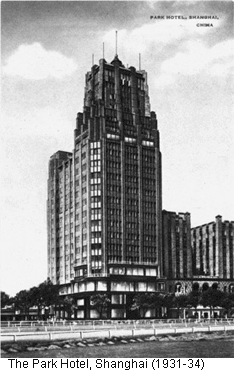 Park Hotel (1931-1934), arguably the most sensational of his buildings, and a landmark of Shanghai, was commissioned by the biggest banking consortium in China. It was the first skyscraper to be built outside America and until the early 1980s it was the city’s tallest building. Quite apart from its height – a modest 22 storeys above ground – it rivalled other buildings of the period in every respect, including its express lifts, the glitter of Hudec’s Art Deco fittings, a range of banquet halls and luxurious suites and a retractable roof over the penthouse nightclub. Indeed, it was executed with bravura. Given that the ground on which Shanghai is built is alluvial, it had been the rule until then to make allowances at the time of construction for any subsidence, and to build everything that much higher. Thus, the entrance of Park Hotel at the initial stage of its construction seemed to be floating at a height of a yard and a half. In Shanghai subsidence never stopped. Hudec’s skyscraper was the first building not to sink either during or after construction because he took advantage of the latest German technology with which the reinforced piling for the foundations was laid. (The building work was followed throughout with open-mouthed wonder by a Shanghai boy by the name of Ieoh Ming Pei, who was then inspired to take up architecture and eventually found fame for the large glass pyramid which since 1989 has formed the main entrance to the Louvre in Paris.)
Park Hotel (1931-1934), arguably the most sensational of his buildings, and a landmark of Shanghai, was commissioned by the biggest banking consortium in China. It was the first skyscraper to be built outside America and until the early 1980s it was the city’s tallest building. Quite apart from its height – a modest 22 storeys above ground – it rivalled other buildings of the period in every respect, including its express lifts, the glitter of Hudec’s Art Deco fittings, a range of banquet halls and luxurious suites and a retractable roof over the penthouse nightclub. Indeed, it was executed with bravura. Given that the ground on which Shanghai is built is alluvial, it had been the rule until then to make allowances at the time of construction for any subsidence, and to build everything that much higher. Thus, the entrance of Park Hotel at the initial stage of its construction seemed to be floating at a height of a yard and a half. In Shanghai subsidence never stopped. Hudec’s skyscraper was the first building not to sink either during or after construction because he took advantage of the latest German technology with which the reinforced piling for the foundations was laid. (The building work was followed throughout with open-mouthed wonder by a Shanghai boy by the name of Ieoh Ming Pei, who was then inspired to take up architecture and eventually found fame for the large glass pyramid which since 1989 has formed the main entrance to the Louvre in Paris.)
By the end of the 1920s Hudec had shown copious evidence of his stylistic virtuosity. He had designed a housing estate for 75 building sites with mobile units with essentially identical ground plans. Details and space configurations could be altered even during construction to meet clients’ needs. Then, starting with the early 1930s, Hudec introduced other contemporary Western architectural trends to China. The Brick Expressionist architects of Northern Germany and their preference for facing bricks became a particularly strong influence. Among Hudec’s Shanghai buildings, the headquarters for the China Baptist Publication Society and the China Christian Literature Society (1930-32) stand besides Fritz Höger’s public buildings in Hamburg as models of the trend. He was able to respond with great speed and sensitivity to shifts in style, and his oeuvre embraces many other trends of the first half of the twentieth century, both conservative and progressive.
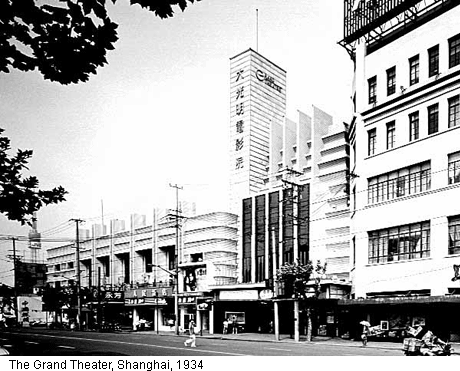 Before finishing work on the vigorous skyward sweep of the Park Hotel, Hudec made a start on another emblematic work, the Grand Theatre (1931-33), known today as the Grand Cinema. As in America and Europe, in Shanghai, too, the thirties were a golden era of the cinema. Cinemas catering to the needs of various social classes and types of film were built in quick succession. The Grand Theatre was the largest and most elegant of Shanghai cinemas. With the Park Hotel, it immediately put Shanghai on the architectural map and both promptly featured in leading Western architectural periodicals such as Baumeister and L’Architecture d’Aujourd’hui. Although primarily designed to show films, the theatre, seating 2,400, also had a stage suitable for live performances; it was even big enough to accommodate a full symphony orchestra. (On one occasion, fire broke out while a film was being shown; a new sprinkler system planned by Hudec ensured that the public were able to escape with their lives.) Hudec set a record for the sheer size of the concrete structure with its huge balcony. The gigantic grand staircase and foyer are masterpieces of a style of interior architecture which blended Art Deco with modernism. From the outside, the theatre is of the type called “poster building” as its structure and protuberances featured as eye-catching devices in their own right, often unrelated to the interior spaces. Its glass tower, internally illuminated at night, was an outstanding early example of the self-promoting light effects which have since become dominant in the entertainment industry.
Before finishing work on the vigorous skyward sweep of the Park Hotel, Hudec made a start on another emblematic work, the Grand Theatre (1931-33), known today as the Grand Cinema. As in America and Europe, in Shanghai, too, the thirties were a golden era of the cinema. Cinemas catering to the needs of various social classes and types of film were built in quick succession. The Grand Theatre was the largest and most elegant of Shanghai cinemas. With the Park Hotel, it immediately put Shanghai on the architectural map and both promptly featured in leading Western architectural periodicals such as Baumeister and L’Architecture d’Aujourd’hui. Although primarily designed to show films, the theatre, seating 2,400, also had a stage suitable for live performances; it was even big enough to accommodate a full symphony orchestra. (On one occasion, fire broke out while a film was being shown; a new sprinkler system planned by Hudec ensured that the public were able to escape with their lives.) Hudec set a record for the sheer size of the concrete structure with its huge balcony. The gigantic grand staircase and foyer are masterpieces of a style of interior architecture which blended Art Deco with modernism. From the outside, the theatre is of the type called “poster building” as its structure and protuberances featured as eye-catching devices in their own right, often unrelated to the interior spaces. Its glass tower, internally illuminated at night, was an outstanding early example of the self-promoting light effects which have since become dominant in the entertainment industry.
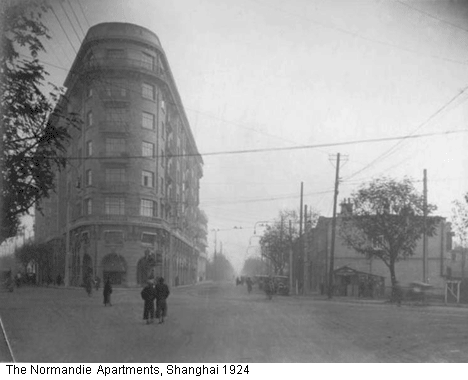 The wide range of Hudec’s work includes residential blocks (his name is associated with the first functionalist multi-tenant block of luxury apartments in China), schools, churches, offices and a number of extraordinary industrial complexes, including the Shanghai waterworks andthe biggest brewery in China of the time, the Union Brewery. A residence for Dr D.W. Wu (1935-38) marked his last significant project there (the escalation of the Sino-Japanese War after the Japanese army’s attack on and occupation of the Chinese-administered parts of Shanghai in 1937 limited Hudec’s activities to a few commissions by the Churches). The press referred to it as the most modern and luxurious residence in the whole of the Far East, incorporating as it did the formal principles of Erich Mendelsohn and Le Corbusier. The building, at the request of Wu’s wife, included a traditional cultic space – the ancestor’s shrine – alongside reception rooms for the highly influential businessman’s guests, and a classroom where their many children were tutored. Hudec gave precedence, within the formalistic world of functionalism, to arched forms for closed balconies, entrances and staircases as they were employed by contemporary Hungarian architects in their designs for private residences as opposed to a rigidly rectangular, strictly modernist, geometry. Virgil Borbíró, the editor of tér és forma, featured Wu’s house in an article. On visits to Hungary, Hudec kept in touch with colleagues such as his old teachers, Iván Kotsis and Virgil Nagy, as well as the likes of Jenô Kismarty Lechner and Ervin Ybl.
The wide range of Hudec’s work includes residential blocks (his name is associated with the first functionalist multi-tenant block of luxury apartments in China), schools, churches, offices and a number of extraordinary industrial complexes, including the Shanghai waterworks andthe biggest brewery in China of the time, the Union Brewery. A residence for Dr D.W. Wu (1935-38) marked his last significant project there (the escalation of the Sino-Japanese War after the Japanese army’s attack on and occupation of the Chinese-administered parts of Shanghai in 1937 limited Hudec’s activities to a few commissions by the Churches). The press referred to it as the most modern and luxurious residence in the whole of the Far East, incorporating as it did the formal principles of Erich Mendelsohn and Le Corbusier. The building, at the request of Wu’s wife, included a traditional cultic space – the ancestor’s shrine – alongside reception rooms for the highly influential businessman’s guests, and a classroom where their many children were tutored. Hudec gave precedence, within the formalistic world of functionalism, to arched forms for closed balconies, entrances and staircases as they were employed by contemporary Hungarian architects in their designs for private residences as opposed to a rigidly rectangular, strictly modernist, geometry. Virgil Borbíró, the editor of tér és forma, featured Wu’s house in an article. On visits to Hungary, Hudec kept in touch with colleagues such as his old teachers, Iván Kotsis and Virgil Nagy, as well as the likes of Jenô Kismarty Lechner and Ervin Ybl.
In 1947, as a “panderer to bourgeois circles”, Hudec was again forced to escape. He even bribed a prison guard and fled the Communist takeover in China. Though all his life he wished for nothing more than to return to Hungary, after the war, this was not an option. After a brief stint in Lugano he moved to Rome to participate in the excavations then being undertaken on an early Christian necropolis under St Peter’s. Even as a student Hudec had shown great interest in archaeology and religion, which he kept up to the end of his life. During his years in China he had read up on the archaeology of the Roman Empire and he also learnt Italian from Italian priests who had been active (as emissaries of the Vatican) in Shanghai. It was due to his studies and his exceptional contacts with the Church that he was received at all, let alone guided through the secret excavations of Saint Peter’s tomb. He was also given an opportunity to take photographs as well as to help with the ordering of documentation as a result of which he was able to give a lecture on the subject at the University of California, Berkeley. It attracted a great deal of interest, as his was a first-hand account of a project no one had known about. Hudec was ultimately able to settle in the United States, but his architectural career had come to an end. He had created his huge oeuvre in less than two decades. In 1958 he died at the age of sixty-five of a heart attack.
The cradle of Asia’s modern architecture was rocked by more than one Eastern European: the Czech architect Antonín Raymond mainly worked in Japan. Hudec maintained close relations with him. For years, he and his family spent their summer holidays at Raymond’s country home. While Hudec, unlike Raymond, did not found a school, and even if the Park Hotel is now dwarfed by a mass of skyscrapers – the tallest skyscraper in the world, sixty times higher than the Park Hotel, is being built in Shanghai – he is still seen as the single most important formative influence on architectural modernism in China.
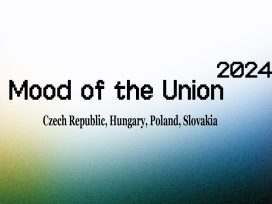
 Park Hotel (1931-1934), arguably the most sensational of his buildings, and a landmark of Shanghai, was commissioned by the biggest banking consortium in China. It was the first skyscraper to be built outside America and until the early 1980s it was the city’s tallest building. Quite apart from its height – a modest 22 storeys above ground – it rivalled other buildings of the period in every respect, including its express lifts, the glitter of Hudec’s Art Deco fittings, a range of banquet halls and luxurious suites and a retractable roof over the penthouse nightclub. Indeed, it was executed with bravura. Given that the ground on which Shanghai is built is alluvial, it had been the rule until then to make allowances at the time of construction for any subsidence, and to build everything that much higher. Thus, the entrance of Park Hotel at the initial stage of its construction seemed to be floating at a height of a yard and a half. In Shanghai subsidence never stopped. Hudec’s skyscraper was the first building not to sink either during or after construction because he took advantage of the latest German technology with which the reinforced piling for the foundations was laid. (The building work was followed throughout with open-mouthed wonder by a Shanghai boy by the name of Ieoh Ming Pei, who was then inspired to take up architecture and eventually found fame for the large glass pyramid which since 1989 has formed the main entrance to the Louvre in Paris.)
Park Hotel (1931-1934), arguably the most sensational of his buildings, and a landmark of Shanghai, was commissioned by the biggest banking consortium in China. It was the first skyscraper to be built outside America and until the early 1980s it was the city’s tallest building. Quite apart from its height – a modest 22 storeys above ground – it rivalled other buildings of the period in every respect, including its express lifts, the glitter of Hudec’s Art Deco fittings, a range of banquet halls and luxurious suites and a retractable roof over the penthouse nightclub. Indeed, it was executed with bravura. Given that the ground on which Shanghai is built is alluvial, it had been the rule until then to make allowances at the time of construction for any subsidence, and to build everything that much higher. Thus, the entrance of Park Hotel at the initial stage of its construction seemed to be floating at a height of a yard and a half. In Shanghai subsidence never stopped. Hudec’s skyscraper was the first building not to sink either during or after construction because he took advantage of the latest German technology with which the reinforced piling for the foundations was laid. (The building work was followed throughout with open-mouthed wonder by a Shanghai boy by the name of Ieoh Ming Pei, who was then inspired to take up architecture and eventually found fame for the large glass pyramid which since 1989 has formed the main entrance to the Louvre in Paris.) Before finishing work on the vigorous skyward sweep of the Park Hotel, Hudec made a start on another emblematic work, the Grand Theatre (1931-33), known today as the Grand Cinema. As in America and Europe, in Shanghai, too, the thirties were a golden era of the cinema. Cinemas catering to the needs of various social classes and types of film were built in quick succession. The Grand Theatre was the largest and most elegant of Shanghai cinemas. With the Park Hotel, it immediately put Shanghai on the architectural map and both promptly featured in leading Western architectural periodicals such as Baumeister and L’Architecture d’Aujourd’hui. Although primarily designed to show films, the theatre, seating 2,400, also had a stage suitable for live performances; it was even big enough to accommodate a full symphony orchestra. (On one occasion, fire broke out while a film was being shown; a new sprinkler system planned by Hudec ensured that the public were able to escape with their lives.) Hudec set a record for the sheer size of the concrete structure with its huge balcony. The gigantic grand staircase and foyer are masterpieces of a style of interior architecture which blended Art Deco with modernism. From the outside, the theatre is of the type called “poster building” as its structure and protuberances featured as eye-catching devices in their own right, often unrelated to the interior spaces. Its glass tower, internally illuminated at night, was an outstanding early example of the self-promoting light effects which have since become dominant in the entertainment industry.
Before finishing work on the vigorous skyward sweep of the Park Hotel, Hudec made a start on another emblematic work, the Grand Theatre (1931-33), known today as the Grand Cinema. As in America and Europe, in Shanghai, too, the thirties were a golden era of the cinema. Cinemas catering to the needs of various social classes and types of film were built in quick succession. The Grand Theatre was the largest and most elegant of Shanghai cinemas. With the Park Hotel, it immediately put Shanghai on the architectural map and both promptly featured in leading Western architectural periodicals such as Baumeister and L’Architecture d’Aujourd’hui. Although primarily designed to show films, the theatre, seating 2,400, also had a stage suitable for live performances; it was even big enough to accommodate a full symphony orchestra. (On one occasion, fire broke out while a film was being shown; a new sprinkler system planned by Hudec ensured that the public were able to escape with their lives.) Hudec set a record for the sheer size of the concrete structure with its huge balcony. The gigantic grand staircase and foyer are masterpieces of a style of interior architecture which blended Art Deco with modernism. From the outside, the theatre is of the type called “poster building” as its structure and protuberances featured as eye-catching devices in their own right, often unrelated to the interior spaces. Its glass tower, internally illuminated at night, was an outstanding early example of the self-promoting light effects which have since become dominant in the entertainment industry. The wide range of Hudec’s work includes residential blocks (his name is associated with the first functionalist multi-tenant block of luxury apartments in China), schools, churches, offices and a number of extraordinary industrial complexes, including the Shanghai waterworks andthe biggest brewery in China of the time, the Union Brewery. A residence for Dr D.W. Wu (1935-38) marked his last significant project there (the escalation of the Sino-Japanese War after the Japanese army’s attack on and occupation of the Chinese-administered parts of Shanghai in 1937 limited Hudec’s activities to a few commissions by the Churches). The press referred to it as the most modern and luxurious residence in the whole of the Far East, incorporating as it did the formal principles of Erich Mendelsohn and Le Corbusier. The building, at the request of Wu’s wife, included a traditional cultic space – the ancestor’s shrine – alongside reception rooms for the highly influential businessman’s guests, and a classroom where their many children were tutored. Hudec gave precedence, within the formalistic world of functionalism, to arched forms for closed balconies, entrances and staircases as they were employed by contemporary Hungarian architects in their designs for private residences as opposed to a rigidly rectangular, strictly modernist, geometry. Virgil Borbíró, the editor of tér és forma, featured Wu’s house in an article. On visits to Hungary, Hudec kept in touch with colleagues such as his old teachers, Iván Kotsis and Virgil Nagy, as well as the likes of Jenô Kismarty Lechner and Ervin Ybl.
The wide range of Hudec’s work includes residential blocks (his name is associated with the first functionalist multi-tenant block of luxury apartments in China), schools, churches, offices and a number of extraordinary industrial complexes, including the Shanghai waterworks andthe biggest brewery in China of the time, the Union Brewery. A residence for Dr D.W. Wu (1935-38) marked his last significant project there (the escalation of the Sino-Japanese War after the Japanese army’s attack on and occupation of the Chinese-administered parts of Shanghai in 1937 limited Hudec’s activities to a few commissions by the Churches). The press referred to it as the most modern and luxurious residence in the whole of the Far East, incorporating as it did the formal principles of Erich Mendelsohn and Le Corbusier. The building, at the request of Wu’s wife, included a traditional cultic space – the ancestor’s shrine – alongside reception rooms for the highly influential businessman’s guests, and a classroom where their many children were tutored. Hudec gave precedence, within the formalistic world of functionalism, to arched forms for closed balconies, entrances and staircases as they were employed by contemporary Hungarian architects in their designs for private residences as opposed to a rigidly rectangular, strictly modernist, geometry. Virgil Borbíró, the editor of tér és forma, featured Wu’s house in an article. On visits to Hungary, Hudec kept in touch with colleagues such as his old teachers, Iván Kotsis and Virgil Nagy, as well as the likes of Jenô Kismarty Lechner and Ervin Ybl.


